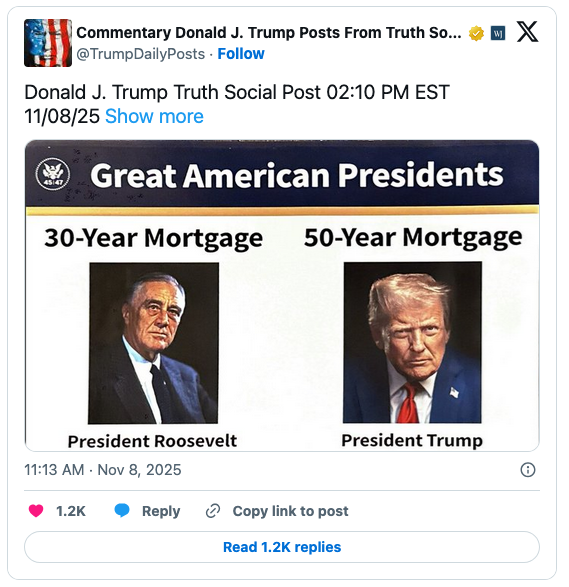
America’s housing dream keeps getting longer. After decades of stretching from 15-year to 30-year loans, President Donald Trump now wants to extend the horizon again – to 50 years. The idea, he says, would make homeownership easier by cutting monthly payments.
On Saturday, Trump posted a graphic on Truth Social that paired Franklin D. Roosevelt’s “30-year mortgage” with his own image under the banner “50-Year Mortgage.” The caption read simply: “Great American Presidents.”

Real-estate investor and Federal Housing Finance Agency advisor Bill Pulte quickly confirmed the plan, calling it “a complete game changer.”
The administration presents it as simple financial sense, a clever way to ease the burden on struggling homeowners. To critics, it looks like something far more familiar — the quiet normalization of lifelong debt, echoing the World Economic Forum’s vision that “you’ll own nothing and be happy.”
“Not Even a Big Deal”
Even within the MAGA base, the proposal drew confusion and pushback. On Monday, Fox News host Laura Ingraham raised the question directly with Trump:
Housing costs are still out of reach, [which is] another thing that your administration is trying to tackle. [For] many Americans, the average age of first-time homebuyers is now up to age 40, which is sad.… Your housing director has proposed something that has enraged your MAGA friends, which is this 50-year mortgage idea. [That caused a] significant MAGA backlash, calling it a giveaway to the banks, and simply prolonging the time it would take for Americans to own a home outright. Is that really a good idea?
Ingraham misstated the origin of the idea — Pulte merely amplified Trump’s post. Still, the question lingered, and Trump brushed it off with characteristic ease:
It’s not even a big deal. I mean, you know you go from 40 to 50 years and what it means is you pay something less …
Ingraham interjected, “It’s 30.”
Trump continued, undeterred:
From 30, some people had a 40, and now they have a 50. All it means is you pay less per month, you pay it over a longer period of time. It’s not like a big factor. It might help a little bit.
He then pivoted to familiar ground, blaming Joe Biden and Federal Reserve Chair Jerome Powell:
Biden did this. He increased the interest rates, and I have a lousy Fed person who’s gonna be gone in a few months.
That line earned particular attention from the libertarian Mises Institute, which is rarely sympathetic to the Federal Reserve but found Trump’s complaint revealing. As the institute observed, Trump was apparently faulting Powell “for the fact that mortgage rates have returned to a more historically normal level of six to seven percent.” The problem, it wrote, was not that Powell had tightened too much, but that he hadn’t “devalued the dollar and inflated the money supply enough to satisfy the inflationist Donald Trump.”
The Math Behind “The Deal”
Trump insists his 50-year mortgage idea is “not even a big deal,” but as explained by Ryan McMaken, editor-in-chief at the Mises Institute, the math tells a very different story. Understanding the true cost requires looking at how mortgages actually work — and how time quietly compounds the burden of debt.
In his piece “Trump’s 50-Year Mortgage Will Bring More Inflation and Corporate Bailouts,” McMaken explains that paying off a mortgage isn’t just a matter of chipping away at the home’s price each month. Every payment is split between the principal and interest, with the early years dominated almost entirely by interest. The longer the term, the more that imbalance grows — and the more money flows to the lender instead of the homeowner.
McMaken illustrates this using a simple example. For a $500,000 loan at 6 percent interest, a 15-year mortgage costs about $259,000 in interest, for a total of roughly $760,000 (excluding taxes and insurance).
Stretch that same loan to 30 years, and the picture changes dramatically: The borrower now pays about $579,000 in interest, more than the amount borrowed, bringing the total to just over $1 million.
But extend the term to 50 years, and the borrower ends up paying over $1 million in interest alone, more than twice the principal. The total cost of the $500,000 home balloons to more than $1.5 million.
And the supposed benefit? The monthly payment only drops by about $350 compared with the 30-year loan.
As McMaken notes, the math exposes the illusion: A 50-year mortgage doesn’t create affordability, it simply extends dependence. Homeowners may feel relief month to month, but they’ll pay for it with decades of extra interest — a trade-off that truly is, in every sense, a big deal for the most.
Inflation and Bailouts
McMaken argues that Trump’s 50-year mortgage plan would not make housing more affordable, but rather expand America’s dependence on debt while pushing inflation higher:
Total mortgage debt will increase as actual ownership in equity will go down. If homeownership does increase, it will be “ownership” of the sort where the homeowner has little to no actual equity.
He notes that “few people ever live in a house for fifty years.” That means the policy “simply ensures that home ‘owners’ will spend their entire lives making big interest payments to banks.”
At the same time, long-term results will be familiar:
It will further financialize the economy, enable more fiat-money fueled debt, and likely require more monetary inflation and more corporate bailouts down the line.
The same institutions that profited from the last housing bubble would benefit again:
Wall Street, banks, and homebuilders will benefit and will like the idea. Builders and real estate agents will sell more homes, and more Americans will be locked into paying even more interest to lenders.
The economist draws a sharp historical comparison:
Trump is right to compare himself to Franklin Roosevelt…. Roosevelt was a corporatist who wedded populist economic policy to the welfare-warfare state. His housing policy led to today’s inflation-fueled system of “too-big-to-fail.” It’s essentially a bankocracy cynically packaged as something to help the common man. Trump continues this tradition.
McMaken’s conclusion is unflinching. The 50-year mortgage, sold as relief for the middle class, would reinforce the same corporate-financial order that both FDR and Trump claimed to challenge.
The Economics of Forever Debt
In a companion piece titled “50-Year Mortgages Won’t Make Housing More Affordable,” economist Connor O’Keeffe argued that lowering monthly payments without addressing housing supply or construction costs won’t make homes more affordable:
At their core, the housing problems we face in this country all come back to one thing: there is an artificial shortage of housing.
Extending the loan term, O’Keeffe argued, would only inflate prices further. He warned:
Government-backed, fifty-year mortgages will make houses more expensive with interest in exchange for lower monthly payments. And, although it’s impossible to quantify before the fact, they could easily worsen the problem by further fueling demand and encouraging people to buy houses they really can’t afford.
The logic is simple enough: when people can borrow more, sellers charge more. Home prices rise, debt swells, and genuine ownership drifts further out of reach. It’s a pattern as old as the modern mortgage itself — first with FDR’s 30-year loans that reshaped the market, and now with Trump’s 50-year version, which could ensure that many buyers won’t live long enough to pay off what they own.





